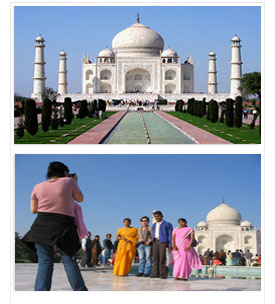







 |
|
||||||||||
 |
 |
|
|||||||||
|
|
|
||||||||||
|
|
|
|
|
||||||||
|
|
|
|
|||||||||
|
|
|||||||||||
|
|
 |
 |
|
||||||||
 |
|
||||||||||
|
|
|||||||||||
|
|
|||||||||||
|
|
|||||||||||
|
|
|
||||||||||
|
|
|||||||||||
|
|
|||||||||||
 |
|
||||||||||
 |
|
||||||||||
|
|
|
|
|
|
|
|
|
|
|
|
|

The Taj Mahal is a mausoleum located in Agra, India was built under Mughal Emperor Shah Jahan in memory of his favorite wife, Mumtaz Mahal.
The Taj Mahal (also "the Taj") is considered as the finest example of Mughal architecture, a style that combines elements from Persian, Turkish, Indian, and Islamic architectural styles. In 1983, Taj Mahal became a UNESCO World Heritage Site and was cited as "the jewel of Muslim art in India and one of the universally admired masterpieces of the world's heritage."
While the white domed marble mausoleum is most familiar, Taj Mahal is an integrated complex of structures and were completed around 1648. Ustad Ahmad Lahauri is generally considered as the principal designer of Taj Mahal.
Origin and inspiration
In 1631, Shah Jahan, emperor during Mughal's period of greatest prosperity, was griefstricken when his third wife, Mumtaz Mahal, died during the birth of their fourteenth child, Gauhara Begum. The court chronicles of Shah Jahan's grief illustrates the love story traditionally held as an inspiration for Taj Mahal. The construction of Taj Mahal begun soon after Mumtaz's death with the principal mausoleum completed in 1648. The surrounding buildings and garden were finished five years later. Visiting Agra in 1663, French traveller François Bernier wrote:
I shall finish this letter with a description of the two wonderful mausoleums which constitute the chief superiority of Agra over Delhi. One was erected by Jehan-guyre [sic] in honour of his father Ekbar; and Chah-Jehan raised the other to the memory of his wife Tage Mehale, that extraordinary and celebrated beauty, of whom her husband was so enamoured it is said that he was constant to her during life, and at her death was so affected as nearly to follow her to the grave.
The Taj Mahal incorporates and expands on design traditions of Persian and earlier Mughal architecture. Specific inspiration came from successful Timurid and Mughal buildings including the Gur-e Amir (the tomb of Timur, progenitor of the Mughal dynasty, in Samarkand), Humayun's Tomb, Itmad-Ud-Daulah's Tomb (sometimes called the Baby Taj), and Shah Jahan's own Jama Masjid in Delhi. While earlier Mughal buildings were primarily constructed of red sandstone, Shah Jahan promoted use of white marble inlaid with semi-precious stones and buildings under his patronage reached new levels of refinement.
For more information, click here.